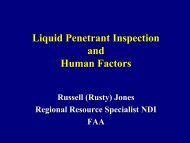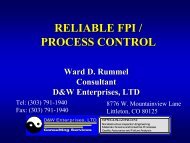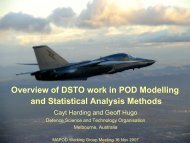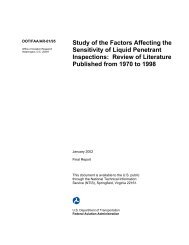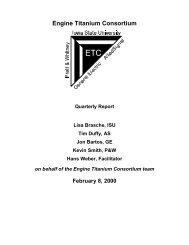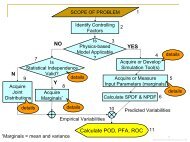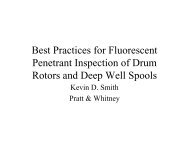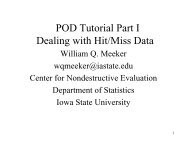Engine Titanium Consortium - Center for Nondestructive Evaluation ...
Engine Titanium Consortium - Center for Nondestructive Evaluation ...
Engine Titanium Consortium - Center for Nondestructive Evaluation ...
You also want an ePaper? Increase the reach of your titles
YUMPU automatically turns print PDFs into web optimized ePapers that Google loves.
Project 2:<br />
Task 2.2:<br />
Subtask 2.2.3:<br />
Inservice Inspection<br />
Inspection Development<br />
Transitions to Airline<br />
Maintenance<br />
<strong>Engine</strong>ering Studies of Cleaning<br />
and Drying Process in<br />
Preparation <strong>for</strong> FPI<br />
Team Members:<br />
HW: Andy Kinney, James Hawkins, Tim<br />
Duffy<br />
ISU: Brian Larson, Rick Lopez, Lisa<br />
Brasche<br />
GE: Terry Kessler, Charlie Loux, Jon<br />
Bartos<br />
PW: Anne D'Orvilliers, Brian MacCracken,<br />
Kevin Smith, Jeff Stevens, John Lively<br />
Students: S. Gorman, L. Rohrhey, and Y. Wang<br />
Program initiation date: February 7, 2000<br />
Objectives:<br />
• To establish a quantifiable measure of cleanliness including the minimum condition to allow<br />
effective inspection processing.<br />
• To establish the effect of local etching on detectability and provide guidance on best practices<br />
<strong>for</strong> removal of local surface damage from FOD and other surface anomalies.<br />
• To determine the effect of chemical cleaning, mechanical cleaning, and drying processes on the<br />
detectability of LCF cracks in titanium and nickel alloys that would be typical in field run<br />
hardware.<br />
• To update existing specifications to reflect the improved processes and provide best practices<br />
documents <strong>for</strong> use by the OEMs and airlines.<br />
Approach:<br />
The overall approach to the FPI studies is shown in the following flowchart with details provided in<br />
the text that follows.<br />
Literature and Industry Survey: The effects of cleanliness, cleaning method, and drying method on<br />
penetrant inspectability will be evaluated. As a first step, a review of the literature related to FPI<br />
processes and cleaning and drying methods will be conducted. Literature related to cleaning<br />
processes as well as NDE processes will be reviewed. Existing CASR literature review data will<br />
serve as a starting point.<br />
A survey of current practices used by the OEMs, airlines, and third party maintenance shops will be<br />
conducted to determine the existing “state of the practice”. Potential partners will be identified <strong>for</strong><br />
participation in the follow on studies on fielded hardware. A team meeting will be held to identify<br />
the cleaning methods and drying methods to be studied and the contaminants of concern. Other<br />
organizations not participating in ETC will be invited to attend the meeting and coordination with<br />
other relevant programs will be maintained. A design of experiments approach will be considered<br />
in order to optimize the use of the results. A set of 40 specimens, 20 titanium and 20 nickel will be<br />
generated by CASR staff.<br />
Quarterly Report – January 1, 2002 –March 31, 2002<br />
print date/time: 6/6/2002 - 8:39 AM – Page 77



